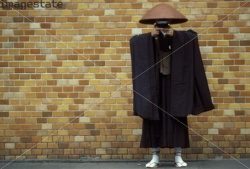Difference between revisions of "Chougu"
(Redirected page to Kasaya) |
|||
| (2 intermediate revisions by the same user not shown) | |||
| Line 1: | Line 1: | ||
| − | + | [[File:1258102.jpg|thumb|250px|]] | |
| + | |||
| + | |||
| + | |||
| + | |||
| + | Three types of [[kesa]] [[Soto]] [[monks]] are supposed to receive upon [[ordination]]: | ||
| + | |||
| + | |||
| + | |||
| + | 1) the five-panel robe ([[gojōe]] [[五條衣]]), a.k.a. [[andae robe]] ([[andae]] [[安陀會]], S. [[antarvāsa]]), | ||
| + | |||
| + | (2) seven-panel robe ([[shichijōe]] [[七條衣]]), a.k.a. [[uttarasō robe]] ([[uttarasō]] [[欝多羅僧]], S. [[uttarāsangha]]), and | ||
| + | |||
| + | (3) [[nine-panel robe]] ([[kujōe]] [[九條衣]]), a.k.a. [[sōgyari robe]] ([[sōgyari]] [[僧伽梨]], S. [[saghāi]]). | ||
| + | |||
| + | |||
| + | According to {{Wiki|Indian}} [[Vinaya]] texts translated into [[Chinese]], [[Buddhist]] [[monks]] are allowed three types of [[robes]]: | ||
| + | |||
| + | |||
| + | (1) an [[antarvāsa]] or "[[under robe]]," ( | ||
| + | |||
| + | 2) an [[uttarāsangha]] or "[[upper robe]]," and (3) a [[saghāi]] or "[[full dress robe]]." | ||
| + | |||
| + | These three types of [[robes]] are [[symbolically]] represented by the three types of [[kesas]] that [[Soto monks]] receive today, but the [[latter]] do not have the same shapes or {{Wiki|practical}} functions as the original {{Wiki|Indian}} [[robes]] they are named after. | ||
| + | |||
| + | "[[andae robe]]," "[[uttarasō robe]]," "[[sōgyari robe]]," "[[kesa]]," "[[robes]]." | ||
| + | {{R}} | ||
| + | [http://global.sotozen-net.or.jp/eng/library/glossary/individual.html?key=three_robes global.sotozen-net.or.jp] | ||
| + | [[Category:Monastic robes]] | ||
Latest revision as of 07:06, 26 February 2016
Three types of kesa Soto monks are supposed to receive upon ordination:
1) the five-panel robe (gojōe 五條衣), a.k.a. andae robe (andae 安陀會, S. antarvāsa),
(2) seven-panel robe (shichijōe 七條衣), a.k.a. uttarasō robe (uttarasō 欝多羅僧, S. uttarāsangha), and
(3) nine-panel robe (kujōe 九條衣), a.k.a. sōgyari robe (sōgyari 僧伽梨, S. saghāi).
According to Indian Vinaya texts translated into Chinese, Buddhist monks are allowed three types of robes:
(1) an antarvāsa or "under robe," (
2) an uttarāsangha or "upper robe," and (3) a saghāi or "full dress robe."
These three types of robes are symbolically represented by the three types of kesas that Soto monks receive today, but the latter do not have the same shapes or practical functions as the original Indian robes they are named after.
"andae robe," "uttarasō robe," "sōgyari robe," "kesa," "robes."
